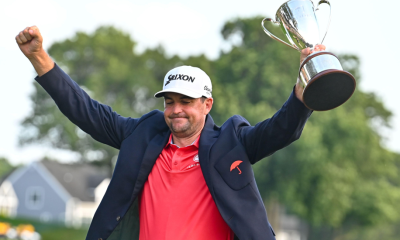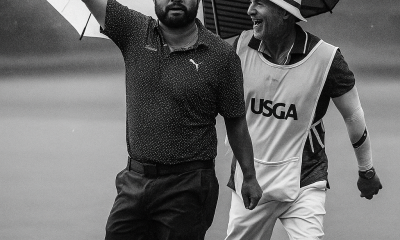Opinion & Analysis
The Enigmatic Mr. Watson

Growing up in Connecticut, I attended first Greater Hartford Open, then the Buick Championship, now the Travelers Championship most every summer.
Of all the tournaments I watched at TPC River Highlands, the only one I saw to its Sunday evening conclusion was in 2010, when Bubba Watson vanquished Corey Pavin and Scott Verplank in a playoff after coming from six shots behind Justin Rose’s 54-hole lead. Watson was overcome with emotion when he accepted his first PGA Tour trophy. Tears streamed down his face as he leaned on wife Angie and he dedicated the victory to his father, who was back in Florida in failing health. As he addressed the cheering crowd, it was easy to sense that it was entirely his.
This past Sunday at TPC River Highlands’ 16th hole, where he had secured his maiden victory three years ago, an evidently very different Bubba Watson faltered. Leading the tournament at the time, Watson’s tee shot — a nine iron — came up short in the pond that guards the green of the 178-yard par 3. Watson, incredulous, threw up his hands and glared at caddie Ted Scott. Scott has seemed to serve a more active role in Watson’s life than most caddies—the tall Floridian has credited Scott in the past with helping build a more positive on-course demeanor.
After rinsing his tee shot, Watson proceeded to the drop area, conferred with Scott and hit a half-wedge shot that careened over the green.
“So you’re telling me that’s the right yardage,” seethed Watson, all condescension.
Viewers, especially those who have caddied before, cringed at the awkwardness of what had just happened. Watson ultimately made triple-bogey on the hole and finished a disappointing fourth place, two shots behind eventual winner Ken Duke.
[youtube id=”cUA9g9HfRPg” width=”620″ height=”360″]
Watson and Scott have publicly made up (thanks, Twitter), laughing off the exchange as something that happened in the heat of competition. But nevertheless, the incident is bound to lose Watson some fans.
Image-wise, Watson’s last three years have been eventful, and not always in a positive way. He won the 2012 Masters in spectacular fashion, yes, but the prior summer, during a trip to play in the European Tour’s French Open, he was reportedly uncooperative with media requests during the week, made some comments that belied little engagement with the culture and promptly missed the cut in the event. The ordeal left European golf fans and media with the impression of Watson as a stereotypical “cowboy American” — culturally clueless and borderline boorish.
Early in 2012, Watson purchased an orange 1969 Dodge Charger, a “General Lee” of “The Dukes of Hazzard” fame for more than $100,000. For some, the extravagance smacked of the same indelicacy Watson exhibited in France but for most, it was merely “Bubba being Bubba.”
In 2013, Watson has had mixed success on the golf course while continuing to build his own personal brand off it, to the extent that some have wondered which side of his life has taken the lead. With new clothing sponsor Oakley, Watson made literal waves in April by appearing in a video that showed off a futuristic mode of golf course transportation: a hovercraft.
[youtube id=”z5u_2bGPdUY” width=”620″ height=”360″]
The stunt generated almost as much buzz as Watson’s two appearances in the pro-golf faux boy-band The Golf Boys’ videos and only added to Watson’s visibility.
[youtube id=”iiiOqybRvsM” width=”620″ height=”360″]
Do not take this as a condemnation of Watson, though, for all its mention of his public foibles. Quite the opposite, in fact: his fun-loving public attitude and down-home roots make him an everyman figure the game has not seen since John Daly — the type of figure golf needs.
He also happens to be one of the longest-hitting and most creative players of the game today, which adds to his appeal by backing up the sizzle with considerable substance. But moments like Sunday’s, when he laid his own ill-execution at the feet of his caddie, available to all who were watching the telecast, are frustrating to all golf fans — this one included — who want the best to be true of Watson.
Here’s hoping Sunday’s behavior was an aberration, rather than an accurate glimpse at the real Bubba Watson.
Opinion & Analysis
The 2 primary challenges golf equipment companies face

As the editor-in-chief of this website and an observer of the GolfWRX forums and other online golf equipment discourse for over a decade, I’m pretty well attuned to the grunts and grumbles of a significant portion of the golf equipment purchasing spectrum. And before you accuse me of lording above all in some digital ivory tower, I’d like to offer that I worked at golf courses (public and private) for years prior to picking up my pen, so I’m well-versed in the non-degenerate golf equipment consumers out there. I touched (green)grass (retail)!
Complaints about the ills of and related to the OEMs usually follow some version of: Product cycles are too short for real innovation, tour equipment isn’t the same as retail (which is largely not true, by the way), too much is invested in marketing and not enough in R&D, top staffer X hasn’t even put the new driver in play, so it’s obviously not superior to the previous generation, prices are too high, and on and on.
Without digging into the merits of any of these claims, which I believe are mostly red herrings, I’d like to bring into view of our rangefinder what I believe to be the two primary difficulties golf equipment companies face.
One: As Terry Koehler, back when he was the CEO of Ben Hogan, told me at the time of the Ft Worth irons launch, if you can’t regularly hit the golf ball in a coin-sized area in the middle of the face, there’s not a ton that iron technology can do for you. Now, this is less true now with respect to irons than when he said it, and is less and less true by degrees as the clubs get larger (utilities, fairways, hybrids, drivers), but there remains a great deal of golf equipment truth in that statement. Think about it — which is to say, in TL;DR fashion, get lessons from a qualified instructor who will teach you about the fundamentals of repeatable impact and how the golf swing works, not just offer band-aid fixes. If you can’t repeatably deliver the golf club to the golf ball in something resembling the manner it was designed for, how can you expect to be getting the most out of the club — put another way, the maximum value from your investment?
Similarly, game improvement equipment can only improve your game if you game it. In other words, get fit for the clubs you ought to be playing rather than filling the bag with the ones you wish you could hit or used to be able to hit. Of course, don’t do this if you don’t care about performance and just want to hit a forged blade while playing off an 18 handicap. That’s absolutely fine. There were plenty of members in clubs back in the day playing Hogan Apex or Mizuno MP-32 irons who had no business doing so from a ballstriking standpoint, but they enjoyed their look, feel, and complementary qualities to their Gatsby hats and cashmere sweaters. Do what brings you a measure of joy in this maddening game.
Now, the second issue. This is not a plea for non-conforming equipment; rather, it is a statement of fact. USGA/R&A limits on every facet of golf equipment are detrimental to golf equipment manufacturers. Sure, you know this, but do you think about it as it applies to almost every element of equipment? A 500cc driver would be inherently more forgiving than a 460cc, as one with a COR measurement in excess of 0.83. 50-inch shafts. Box grooves. And on and on.
Would fewer regulations be objectively bad for the game? Would this erode its soul? Fortunately, that’s beside the point of this exercise, which is merely to point out the facts. The fact, in this case, is that equipment restrictions and regulations are the slaughterbench of an abundance of innovation in the golf equipment space. Is this for the best? Well, now I’ve asked the question twice and might as well give a partial response, I guess my answer to that would be, “It depends on what type of golf you’re playing and who you’re playing it with.”
For my part, I don’t mind embarrassing myself with vintage blades and persimmons chasing after the quasi-spiritual elevation of a well-struck shot, but that’s just me. Plenty of folks don’t give a damn if their grooves are conforming. Plenty of folks think the folks in Liberty Corner ought to add a prison to the museum for such offences. And those are just a few of the considerations for the amateur game — which doesn’t get inside the gallery ropes of the pro game…
Different strokes in the game of golf, in my humble opinion.
Anyway, I believe equipment company engineers are genuinely trying to build better equipment year over year. The marketing departments are trying to find ways to make this equipment appeal to the broadest segment of the golf market possible. All of this against (1) the backdrop of — at least for now — firm product cycles. And golfers who, with their ~15 average handicap (men), for the most part, are not striping the golf ball like Tiger in his prime and seem to have less and less time year over year to practice and improve. (2) Regulations that massively restrict what they’re able to do…
That’s the landscape as I see it and the real headwinds for golf equipment companies. No doubt, there’s more I haven’t considered, but I think the previous is a better — and better faith — point of departure when formulating any serious commentary on the golf equipment world than some of the more cynical and conspiratorial takes I hear.
Agree? Disagree? Think I’m worthy of an Adam Hadwin-esque security guard tackle? Let me know in the comments.
@golfoncbs The infamous Adam Hadwin tackle ? #golf #fyp #canada #pgatour #adamhadwin ? Ghibli-style nostalgic waltz – MaSssuguMusic
Podcasts
Fore Love of Golf: Introducing a new club concept

Episode #16 brings us Cliff McKinney. Cliff is the founder of Old Charlie Golf Club, a new club, and concept, to be built in the Florida panhandle. The model is quite interesting and aims to make great, private golf more affordable. We hope you enjoy the show!
Opinion & Analysis
On Scottie Scheffler wondering ‘What’s the point of winning?’

Last week, I came across a reel from BBC Sport on Instagram featuring Scottie Scheffler speaking to the media ahead of The Open at Royal Portrush. In it, he shared that he often wonders what the point is of wanting to win tournaments so badly — especially when he knows, deep down, that it doesn’t lead to a truly fulfilling life.
View this post on Instagram
“Is it great to be able to win tournaments and to accomplish the things I have in the game of golf? Yeah, it brings tears to my eyes just to think about it because I’ve literally worked my entire life to be good at this sport,” Scheffler said. “To have that kind of sense of accomplishment, I think, is a pretty cool feeling. To get to live out your dreams is very special, but at the end of the day, I’m not out here to inspire the next generation of golfers. I’m not out here to inspire someone to be the best player in the world, because what’s the point?”
Ironically — or perhaps perfectly — he went on to win the claret jug.
That question — what’s the point of winning? — cuts straight to the heart of the human journey.
As someone who’s spent over two decades in the trenches of professional golf, and in deep study of the mental, emotional, and spiritual dimensions of the game, I see Scottie’s inner conflict as a sign of soul evolution in motion.
I came to golf late. I wasn’t a junior standout or college All-American. At 27, I left a steady corporate job to see if I could be on the PGA Tour starting as a 14-handicap, average-length hitter. Over the years, my journey has been defined less by trophies and more by the relentless effort to navigate the deeply inequitable and gated system of professional golf — an effort that ultimately turned inward and helped me evolve as both a golfer and a person.
One perspective that helped me make sense of this inner dissonance around competition and our culture’s tendency to overvalue winning is the idea of soul evolution.
The University of Virginia’s Division of Perceptual Studies has done extensive research on reincarnation, and Netflix’s Surviving Death (Episode 6) explores the topic, too. Whether you take it literally or metaphorically, the idea that we’re on a long arc of growth — from beginner to sage elder — offers a profound perspective.
If you accept the premise literally, then terms like “young soul” and “old soul” start to hold meaning. However, even if we set the word “soul” aside, it’s easy to see that different levels of life experience produce different worldviews.
Newer souls — or people in earlier stages of their development — may be curious and kind but still lack discernment or depth. There is a naivety, and they don’t yet question as deeply, tending to see things in black and white, partly because certainty feels safer than confronting the unknown.
As we gain more experience, we begin to experiment. We test limits. We chase extreme external goals — sometimes at the expense of health, relationships, or inner peace — still operating from hunger, ambition, and the fragility of the ego.
It’s a necessary stage, but often a turbulent and unfulfilling one.
David Duval fell off the map after reaching World No. 1. Bubba Watson had his own “Is this it?” moment with his caddie, Ted Scott, after winning the Masters.
In Aaron Rodgers: Enigma, reflecting on his 2011 Super Bowl win, Rodgers said:
“Now I’ve accomplished the only thing that I really, really wanted to do in my life. Now what? I was like, ‘Did I aim at the wrong thing? Did I spend too much time thinking about stuff that ultimately doesn’t give you true happiness?’”
Jim Carrey once said, “I think everybody should get rich and famous and do everything they ever dreamed of so they can see that it’s not the answer.”
Eventually, though, something shifts.
We begin to see in shades of gray. Winning, dominating, accumulating—these pursuits lose their shine. The rewards feel more fleeting. Living in a constant state of fight-or-flight makes us feel alive, yes, but not happy and joyful.
Compassion begins to replace ambition. Love, presence, and gratitude become more fulfilling than status, profits, or trophies. We crave balance over burnout. Collaboration over competition. Meaning over metrics.
Interestingly, if we zoom out, we can apply this same model to nations and cultures. Countries, like people, have a collective “soul stage” made up of the individuals within them.
Take the United States, for example. I’d place it as a mid-level soul: highly competitive and deeply driven, but still learning emotional maturity. Still uncomfortable with nuance. Still believing that more is always better. Despite its global wins, the U.S. currently ranks just 23rd in happiness (as of 2025). You might liken it to a gifted teenager—bold, eager, and ambitious, but angsty and still figuring out how to live well and in balance. As much as a parent wants to protect their child, sometimes the child has to make their own mistakes to truly grow.
So when Scottie Scheffler wonders what the point of winning is, I don’t see someone losing strength.
I see someone evolving.
He’s beginning to look beyond the leaderboard. Beyond metrics of success that carry a lower vibration. And yet, in a poetic twist, Scheffler did go on to win The Open. But that only reinforces the point: even at the pinnacle, the question remains. And if more of us in the golf and sports world — and in U.S. culture at large — started asking similar questions, we might discover that the more meaningful trophy isn’t about accumulating or beating others at all costs.
It’s about awakening and evolving to something more than winning could ever promise.






















D-mac
Jun 27, 2013 at 2:33 pm
Bubba is an emotional mess! Witness his wins always end in the floodgates opening up. Then, when he hits a bad shot, he blames his caddy. Yea, maybe it’s the swing…with more movement than a sumo wrestler after an all-nighter at a Mexican restaurant. Dude, get some help!
MLH44
Jun 27, 2013 at 7:39 am
I believe Brad hit the nail on the head. They are playing for a “W” worth $300-$500,000. They are in the heat of competition and emotions are red lined. Bubba wanted to pull an 8iron, but Scott convinced him to use a 9iorn. If the 9iron lands 5 feet from the hole, Scott is a hero. As we know it did not therefore Scott was held accountable, unfortunately, publicly. Give Bubba a break, cause although he was the one pulling the trigger, Scott was the one that handed Bubba the gun. Add to the mix HD mics and HD cameras all over the place and what we heard/saw was probably more common than most of us would like to think. It’s golf at it’s highest level and if they can move on so should we.
Brad
Jun 26, 2013 at 8:37 pm
@t Not a legend? Name one player in the top 50 in the world that has no swing coach, no putting coach, no short game coach, and no long game coach that has won a major? Many can be taught and programmed to do the right things but only legends CREATE greatness …fyi: you can’t.
SC
Jun 26, 2013 at 2:02 pm
Bubba is a one-hit wonder. The Masters will be it for him, as he is unwilling to adapt his game to the golf course he is playing. Take for example the Olympic Club last year, when he wouldn’t give up his driver, even hitting it off the deck a few times. That’s not how great golfers play the game. Also, anyone that buys a car with a Confederate flag painted on the top of it deserves no respect.
wtfci
Jun 26, 2013 at 8:45 am
Based on this argument, you can string together disconnected events to make any person look like a monster.
What Bubba does really well is to get people talking about golf that wouldn’t be talking about it. He gets people watching golf that wouldn’t be watching it. The TPC event was the first event after the US Open. This event gets almost no coverage. The attendance at the event was underperforming. Bubba’s falter in the last three holes was a great story that was told to people that wouldn’t have heard anything about it if he pared the 16th hole in the final round.
Rich
Jun 25, 2013 at 10:14 pm
The Boss is always right? Right!
Brett
Jun 25, 2013 at 8:29 pm
agreed^^^They play the game for money unlike most of us. what if the caddy was wrong? and i find this a non issue because certain people have been caught muttering far worse after a shot multiple times and dont get criticized for it. this is a non story.
Brad
Jun 25, 2013 at 6:18 pm
This is very common in any working relationship. Read something this morning that put it in perspective. It said Bubba basically lost from $300,000-500,000 with that one bad hole. I know who cares when pros make so much right? No, like the great saying ” Don’t hate the player hate the game”. If my business partner and I made a joint decision that his call was correct and it lost us $300-500,000 I have a feeling I would give him some s@#t while still being fully aware of my responsibility in the situation. Don’t forget the fact that Ted said Bubba wanted to pull an 8 and he convinced him to hit the 9. All sounds like a great sunday on the PGA TOUR. Give Bubba a break…he’s a living legend.
t
Jun 26, 2013 at 6:39 pm
Bubba is not a lengend !!!!!!!
Patrick
Jun 25, 2013 at 5:31 pm
The problem is that this isn’t an isolated incident from Bubba. In fact, I’ve never seen a player more willing to blame his caddy that he. Multiple times on live television coverage I’ve seen it happen, and the commentators just ignore. It really makes Bubba look bad, and I’ve never been a fan as a result.
C Masty
Jun 25, 2013 at 2:39 pm
Scott threatened to drop the bag a few years back if Bubba didn’t change his on course attitude. One of the true testaments and reasons I play golf is because real players of the game learn to overcome on course adversity and play through. This was just Bubba showing his true colors. History does tend to repeat itself.
Tony R
Jun 26, 2013 at 2:38 pm
It wasn’t that big of a deal. I wish people would stop and think what these professionals are playing for. It’s not a 2 dollar Nassau at your munie.